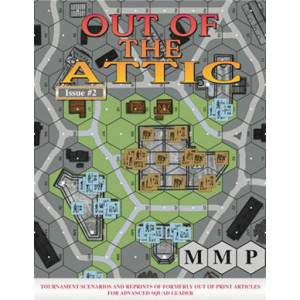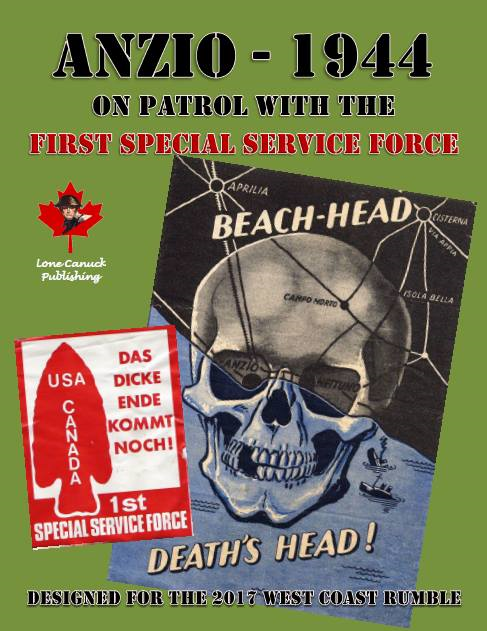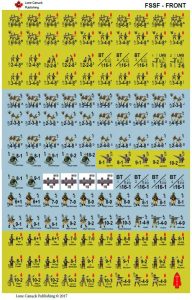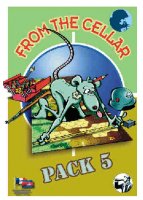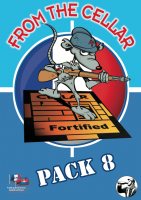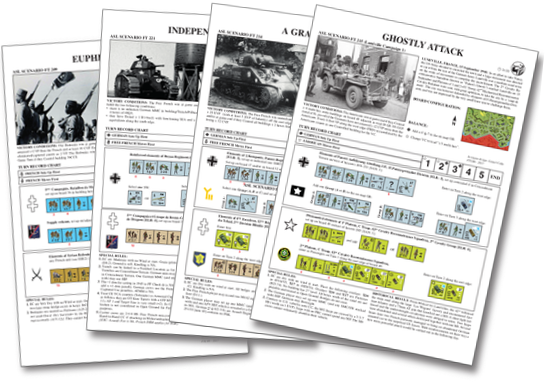
This product contains both a 56 pages magazine and 15 scenarios. The magazine itself contains historical and technical articles on subjects you never dared (or even imagined ?) asking.

What will be a FTC without scenarios ? The 15 scenarios are the products of a variety of designers, from France (of course !), but also from Canada, Germany and even Corsica !
The scenario mix depicts mostly Free French units, alone or with allies but not only. Four of the scenarios can be linked in a mini-campaign :
 |
FT209 |
Euphrates Clash |
 |
vs. |
 |
5 turns |
MAYADINE, SYRIA, 29 September 1941 : After the conquest of French Levant by the Allied, the garrison of the region was mostly done by Free French units. The Bataillon de Marche n°2, part of the 1ère Division Française Libre, was given garrison duty in the eastern part of Syria. On 29 september, a light supply column was attacked by a thousand (according to French sources) Bedouins at the village entry. The 5th company of the Bataillon de Marche n°2 in a defensive position in the military police building reacted swiftly to help their comrades.
 |
FT210 |
The Longest Week |
 |
vs. |
 |
5 turns |
MOUNT SAN BASILIO, SICILY 5 August 1943 : A dramatic week of battles starting 31 July characterized the fierce inland fighting in Sicily during Operation Husky. The American Seventh Army’s First Division and two Canadian regiments fought off two dozens of counterattacks against mixed Axis Forces supported by artillery shelling enemy positions in the rocky hillsides. The battle focused mainly around the numerous hills and mountains surrounding Troina which the Germans had heavily fortified and used as bases for direct and indirect fire. By 5 August, German infantry counter-attacked again, starting another round of furious fighting to dislodge Americans from the hills and save Troina for another day.
 |
FT211 |
9è company sacrifice |
 |
vs. |
 |
7 turns |
HILL 470, NEAR COLLE BELVEDERE, ITALY, 26 January 1944 : The French 3 ème Division d’Infanterie Algérienne was tasked to attack the German forces near Cassino to divert German troops from the main thrust. This diversion was to take place on bare and steep hills north of Cassino known as “Colle Belvedere”. The mission already very dangerous would have been transformed in a suicide attack if the flanking fires from hill 470 on the east side of the attack were not silenced. The 9ème Compagnie, 4ème Régiment de Tirailleurs Tunisiens, had to take this bare hill and hold it at all costs to allow the whole attack to succeed.
 |
FT212 |
For Hitler, for Allah |
 |
vs. |
 |
5.5 turns |
AREA OF SEKOVICI, BOSNIA, 1 May 1944 : In 1943 Reichsführer-SS Heinrich Himmler gave orders to establish a new waffen-SS division, consisting of Muslim Bosniaks. This new division should relieve Wehrmacht units in Yugoslavia for further deployment on the eastern front. The Division saw engagements in smaller anti-partisan operations and at the end of april 1944 the first larger operation took place, the goal of “Operation Maibaum” was the destruction of the III. Bosnian Partisan-Korps, consisting of three divisions which were located in the area of the river Drina. In course of “Operation Maibaum”, parts of the I.SS- Freiwillige-Gebirgs-Regiment 28 were trapped in the village of Sekovici. To save them from total annihilation, the II.Bataillon of the regiment attacked the partisans in the hillside around the village.
 |
FT213 |
Up the Liri Valley |
 |
vs. |
 |
5 turns |
LIRI VALLEY, ITALY, 17 May 1944 : During Operation Diadem, the 1st “Free French” Division was given the task to shield the right flank of the French Mountain Corps which was to lead the main attack into the difficult Aurunci Mountains. On 17th May, the French were progressing quickly along the Liri River valley thanks to the retreat of the German troops after the breakthrough around Monte Petrella. Around noon, the leading elements of the BM11 (March Battalion 11), abandoned by the accompanying tanks that were stopped sooner by mines, were stopped by MG fire coming from fortified houses on both sides of the road.
 |
FT214 |
A grain of Sand |
 |
vs. |
 |
5.5 turns |
LES SABLONS, FRANCE, 10 August 1944 : Just after the fights for Mézière-sous-Ballon started the Normandy campaign for the French 2ème Division Blindée. Within the US 15 th Army Corps, it was part of the southern part of the move to encircle the Germans in the Falaise cauldron. The 10 th of August 1944, the first elements of Groupe Minjonnet met a strong and well concealed German force from the just arrived 9.Panzer-Division in the woods and bocage near Les Sablons farm just before arriving in Mézière-sous-Ballon that will be the first French city liberated by the 2ème DB.
 |
FT215 |
Ghostly Attack |
 |
vs. |
 |
5 turns |
LUNEVILLE, FRANCE, 15 September 1944 : In an effort to take Nancy, the US Army decided to encircled the town and a large movement was directed to cut it from the rest of the German Army. Lunéville was a medium sized town on the route of movement to complete the encirclement. The 2nd Cavalry Reconnaissance Squadron (known as “Patton’s Ghosts”) reached Lunéville on 15 September and Platoons n°1 and 2 of C Troop, 42nd Mechanized Reconnaissance Cavalry Battalion were sent, with great optimism, to take the city by a ‘coup de main’.
 |
FT216 |
Back in Force |
 |
vs. |
 |
6.5 turns |
LUNEVILLE, FRANCE, 16 September 1944 : After its first attempt to take by surprise the town failed, the 2nd Cavalry Reconnaissance Squadron tried again the next day but this time with the help from the CCR of the 4 th Armored Division attacking from the northwest. The town was held by the remnants of the 15.Panzergrenadier-Division, with only 3,500 men at this time. In fact, the 4th Armored Division alone outnumbered the whole 1st and 5th Panzer Armies in all departments !
 |
FT217 |
Cavalry Delaying Action |
 |
vs. |
 |
6.5 turns |
LUNEVILLE, FRANCE, 18 September 1944 : Based on the reports of prisoners captured on 17 September, 2nd cavalry Group commander, Colonel Charles Reed, became convinced that the Germans were preparing to launch a major counterattack and requested tank destroyer assistance. His request was denied by the XII Corps. On the 18th, the 42nd Cavalry Reconnaissance forces screening the eastern approaches of Luneville announced the arrival of the Panzer-Brigade.111 looking to retake the city. The 42nd would have to buy time to allow the retreat of rest of the 2nd Cavalry Group and the intervention of US heavy tanks.
 |
FT218 |
Taking Luneville |
 |
vs. |
 |
8 turns |
LUNEVILLE, FRANCE, 18 September 1944 : Slowed by the sacrifice of the 42nd Cavalry Reconnaissance Squadron, 2nd Cavalry Group near Moncel, thePanzer-Brigade.111 reached Lunéville late in the morning of the 18 th . The town was already under attack from the remnants of the Panzergrenadier-Regiment.15 that had managed to retake part of the town on the 17th . Time was on the side of the Allies with tanks reinforcements coming in at maximum speed. The final part of the first battle of Lunéville was about to begin with a major tank clash.
 |
FT219 |
Koniev’s Finest |
 |
vs. |
 |
4.5 turns |
NORTH OF CHMIELNIK, POLAND, 12 JANUARY 45 : Russian army had been bordering the Vistula on its length, holding three bridgeheads on the German side. On the 12th of January, Marshal Koniev unleashed his first Ukrainian front and cleared the German lines of defense. At mid-day, the first and second lines were breached and Koniev had seized his main axis of penetration. He immediately ordered the introduction of his tank units to exploit the gap in German lines. The Germans tried a desperate action and immediately counterattacked the lead Soviet units.
 |
FT220 |
Alsatian Verdun |
  |
vs. |
 |
9.5 turns |
JEBSHEIM, FRANCE, 26 January 1945 : As part of the Colmar pocket, one of the strongest part of the German line was located in the Alsatian village of Jebsheim. The night of the 26th, the 254th Infantry Regiment was ordered to take the village. That night was one of the coldest during that winter with temperature down to –20° C. The night attack had to be cancelled because the troops, which had to cross a frigid stream to reach the village, were freezing and the weapons refused to work. A new attack began at dawn. It will be a difficult day for the 254th and its supporting tanks.
 |
FT221 |
Independance Day |
 |
vs. |
 |
5.5 turns |
DIDONNE, FRANCE, 15 April 1945 : From summer 1944, the Royan area has become one of the fortified pockets of the Atlantic coast, locking the access to the Gironde River as well as to the harbour of Bordeaux. The codename for its conquest would be « operation Independence ». Several units took part in the Operation, such as the 2è Division Blindée, the 13è Régiment de Dragons equipped with French tanks of 1940 or the Bataillon de Marche n°2 manned with soldiers of current Centroafrica. Nevertheless, the defenders were determined to fight and their fortifications looked formidable.
 |
FT222 |
Hetzer Butcher |
 |
vs. |
 |
7 turns |
KÖNIGSBACH, GERMANY, 6 April 1945 : Created in 1943 in North Africa, the “5eme division blindée” landed in France in September 1944 and took part in the Vosges/Colmar salient campaigns and in the invasion of Southern Germany. On the road to Stuttgart, late on April 5th, elements of the french Division took half of the German town of Konigsbach. Early in the morning of the following day, the Germans counterattacked with Volksgrenadiers, SS elements and a Panzer support of 15 Hetzers. The German attack supported by artillery directed from the steep hills dominating the town quickly overhelmed several French positions.
 |
FT223 |
Kings of Bollersdorf |
 |
vs. |
 |
6.5 turns |
BOLLERSDORF, GERMANY, April 19 th 1945 : On the morning of April 19th , during the battle for the Seelow Heights with Berlin as the final objective, the Russians had placed their heaviest armor forward to conduct the expected breakthrough with the 12th Guards Tank Corps, as per their doctrine. Their lead elements, advancing without any proper reconnaissance and infantry support, drove right into several Königstigers of the SS Pz. Abt. 503, that recently arrived from Nordland’s SS Pz. Abt. 11 Hermann von Salza. Forming up outside Bollersdorff were more than one hundred T-34/85 ready to roll through the gap the IS-2 would have opened up in the German lines.

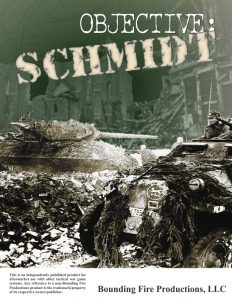 BFP just announced that they are 4-6 weeks from shipping this pack so we are taking orders now so we can get these out to you on the day they come in.
BFP just announced that they are 4-6 weeks from shipping this pack so we are taking orders now so we can get these out to you on the day they come in.



